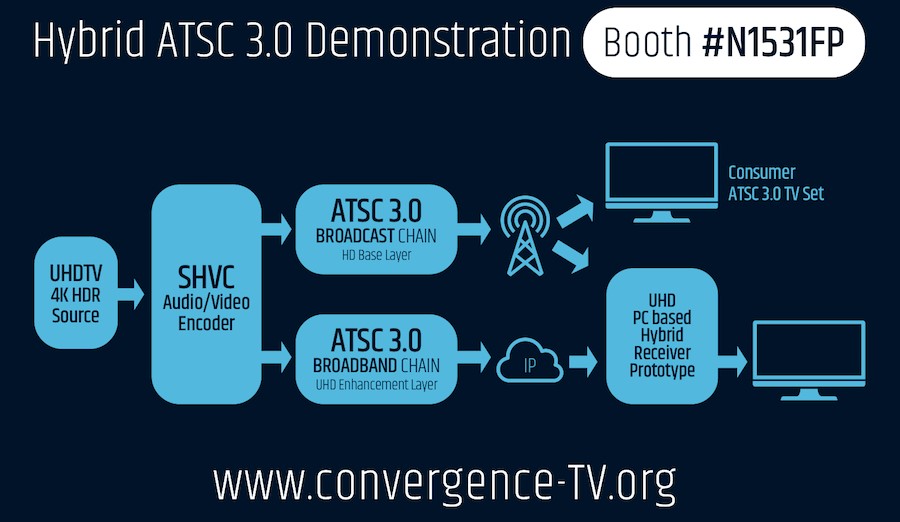NAB Show Demo To Show Power of SHVC Encoding in ATSC 3.0 Ecosystem
LAS VEGAS –TV broadcasters who have wondered what all the hoopla is about when it comes to delivering IP packets as part of Next-Gen TV service rather than today’s MPEG Transport Stream via ATSC 1.0 may want to take the time to visit the Convergence TV Project demo in the NAB Futures Park (booth N1531FP) at the 2018 NAB Show next week.
There, five French companies and two research institutes will put on a joint demonstration of scalable High Efficiency Video Coding, otherwise known as SHVC, for audio and video compression. By encoding with SHVC, which is supported as part of the newly approved ATSC 3.0 standard, TV broadcasters can elect to send certain IP packets over the air and others over the top to connected TVs.

For broadcasters evaluating how best to use their over-the-air bits, SHVC will make it possible to pack more services –whether that’s more OTA channels, new data services or mobile TV—into their 6MHz channel without compromising the delivery of signals to the home TV.
SHVC makes that possible by enabling a base layer of service to be sent over the air and an enhancement layer to be delivered over the top to internet-connected TVs. Thus, broadcasters are relieved from the burden of carrying the full load of IP packets needed to make, for instance, a 4K UHD HDR picture, while maintaining the ability to deliver 4K UHD HDR to the home where the OTA base layer and OTT enhancement layer are added back together.
Essentially, SHVC as part of ATSC 3.0 will allow TV broadcasters to have their cake and eat it, too. In other words, they will be able to deliver the highest quality video and audio to the home while preserving their ability to deliver more services over the air.
[Read: Sinclair Taps ATEME For ATSC Encoding]
This base-enhancement layer combo should also allow broadcasters to overcome one of the biggest reasons Mobile DTV failed: simulcasting and broadcast rights.
Get the TV Tech Newsletter
The professional video industry's #1 source for news, trends and product and tech information. Sign up below.
James Goodmon Sr., Capitol Broadcasting CEO and Chairman of the Board, recounted the problem during a recent demo of NBCOlympics’ 4K UHD coverage from PyeongChang, South Korea, being delivered over the air from an experimental 3.0 station WRAL is running.
Goodmon told those gathered for the demo that the only way to deliver Mobile DTV in an ATSC 1.0 (A/53) era was with a simulcast of a separate service relying on A/153. Red flags went up for affiliates when the legal teams of their network partners insisted the A/153 transmission was a separate channel, and that the affiliates had not acquired the rights to simulcast their main channel on this new mobile channel. With SHVC as part of ATSC 3.0, no simulcast is necessary.
The objective of the NAB demo will be to show delivery of a full UHD service using an OTA ATSC 3.0 broadcast for HD HDR service and a 3.0 broadband path for enhancing the service from HD to 4K UHD with HDR. On the reception side of the equation, a normal ATSC 3.0 TV will display the HD HDR service, and a PC-based hybrid receiver prototype will combine the base and enhancement layers to display 4K UHD HDR.
The demo will also illustrate that it is possible for a regular HEVC-enabled TV set to decode the SHVC base layer without needing an upgrade, thus underscoring the backward compatibility of SHVC.
The Convergence TV Project, sponsored by the French government and two local councils, is the work of five tech companies, including TeamCast, ATEME, Broadpeak, Motion Spell and TDF. Two prestigious French academic research institutes, INSA Rennes and Telecom Paristech, are also a part of the project.
Samsung is supporting the NAB demo by providing the ATSC 3.0 TV set to demonstrate backward compatibility.
Visit the demonstration at NAB Show booth N1531FP.
For a comprehensive list of TV Technology’s ATSC 3.0 coverage, see our ATSC3 silo.
Phil Kurz is a contributing editor to TV Tech. He has written about TV and video technology for more than 30 years and served as editor of three leading industry magazines. He earned a Bachelor of Journalism and a Master’s Degree in Journalism from the University of Missouri-Columbia School of Journalism.

